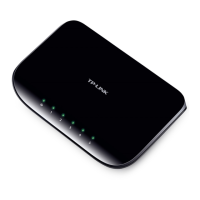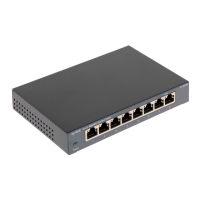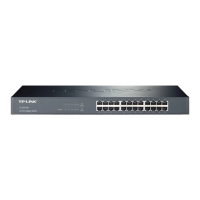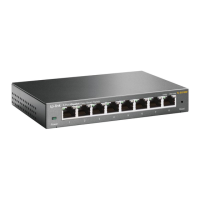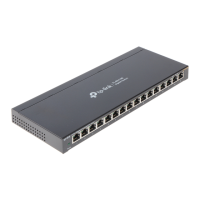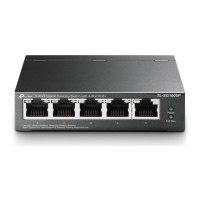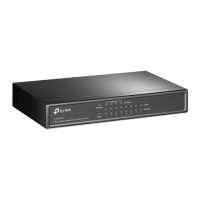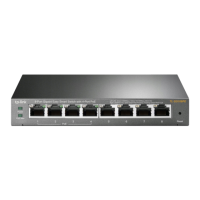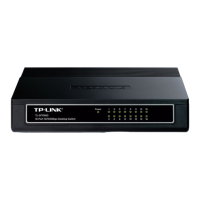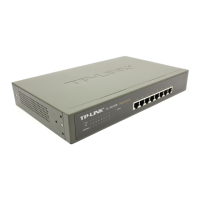Do you have a question about the TP-Link Easy Smart Switch and is the answer not in the manual?
Specifies the target audience for this user guide, typically network managers familiar with IT concepts.
Details the formatting and symbols used for consistent information presentation.
Directs users to additional resources like download centers and support pages.
Provides a summary of the Easy Smart Switch's capabilities and target applications.
Step-by-step instructions for accessing the switch's web interface for configuration.
Explains the System module's functions and supported features.
Guides on viewing and setting the switch's device description and system information.
Details on setting the switch's IP address using DHCP or manual configuration.
Instructions for enabling or disabling the LED indicators on supported devices.
Procedures for changing the administrator username and password for security.
How to save and load switch configurations to manage settings effectively.
Steps to safely restart the switch to apply changes or troubleshoot issues.
Process for restoring the switch to its factory default settings.
Guide for updating the switch's firmware for new features and performance improvements.
Reference table for default system settings.
Introduces switching functions: port settings, IGMP Snooping, and LAG.
Details on setting port status, speed, duplex, and flow control.
Enabling and configuring IGMP Snooping for efficient multicast traffic management.
Bundling physical ports into a logical interface for increased bandwidth and reliability.
Practical examples for IGMP Snooping and LAG configurations.
Reference table for default switching parameters.
Introduces monitoring functions for traffic analysis and fault detection.
How to check traffic statistics, packet counts, and error rates for each port.
Setting up port mirroring to capture and analyze network traffic.
Diagnosing network cable connection status and identifying faults.
Enabling and configuring loop detection to prevent network loops.
Reference table for default monitoring parameters.
Explains VLAN technology and its benefits for network segmentation and security.
Details on configuring MTU VLAN, including uplink and other port assignments.
Guides on assigning ports to specific VLANs for network segmentation.
Setting up 802.1Q VLANs with tagged and untagged ports for advanced segmentation.
A practical example demonstrating 802.1Q VLAN setup for network traffic control.
Reference table for default VLAN configuration parameters.
Introduces Quality of Service (QoS) for prioritizing network traffic.
Details on setting up QoS using Port Based, 802.1P, or DSCP priority modes.
Setting ingress and egress bandwidth limits on ports to manage traffic rates.
Enabling storm control to limit broadcast, multicast, and unknown unicast traffic.
Example of configuring port-based QoS to prioritize specific traffic.
Reference table for default QoS configuration parameters.
Explains Power over Ethernet (PoE) technology and its application.
Guides on setting system power limits and per-port PoE status and priority.
Enabling and configuring PoE Auto Recovery for PD connection management.
Reference table for default PoE configuration parameters.
Specifies the target audience for this user guide, typically network managers familiar with IT concepts.
Details the formatting and symbols used for consistent information presentation.
Directs users to additional resources like download centers and support pages.
Provides a summary of the Easy Smart Switch's capabilities and target applications.
Step-by-step instructions for accessing the switch's web interface for configuration.
Explains the System module's functions and supported features.
Guides on viewing and setting the switch's device description and system information.
Details on setting the switch's IP address using DHCP or manual configuration.
Instructions for enabling or disabling the LED indicators on supported devices.
Procedures for changing the administrator username and password for security.
How to save and load switch configurations to manage settings effectively.
Steps to safely restart the switch to apply changes or troubleshoot issues.
Process for restoring the switch to its factory default settings.
Guide for updating the switch's firmware for new features and performance improvements.
Reference table for default system settings.
Introduces switching functions: port settings, IGMP Snooping, and LAG.
Details on setting port status, speed, duplex, and flow control.
Enabling and configuring IGMP Snooping for efficient multicast traffic management.
Bundling physical ports into a logical interface for increased bandwidth and reliability.
Practical examples for IGMP Snooping and LAG configurations.
Reference table for default switching parameters.
Introduces monitoring functions for traffic analysis and fault detection.
How to check traffic statistics, packet counts, and error rates for each port.
Setting up port mirroring to capture and analyze network traffic.
Diagnosing network cable connection status and identifying faults.
Enabling and configuring loop detection to prevent network loops.
Reference table for default monitoring parameters.
Explains VLAN technology and its benefits for network segmentation and security.
Details on configuring MTU VLAN, including uplink and other port assignments.
Guides on assigning ports to specific VLANs for network segmentation.
Setting up 802.1Q VLANs with tagged and untagged ports for advanced segmentation.
A practical example demonstrating 802.1Q VLAN setup for network traffic control.
Reference table for default VLAN configuration parameters.
Introduces Quality of Service (QoS) for prioritizing network traffic.
Details on setting up QoS using Port Based, 802.1P, or DSCP priority modes.
Setting ingress and egress bandwidth limits on ports to manage traffic rates.
Enabling storm control to limit broadcast, multicast, and unknown unicast traffic.
Example of configuring port-based QoS to prioritize specific traffic.
Reference table for default QoS configuration parameters.
Explains Power over Ethernet (PoE) technology and its application.
Guides on setting system power limits and per-port PoE status and priority.
Enabling and configuring PoE Auto Recovery for PD connection management.
Reference table for default PoE configuration parameters.
| Cable Diagnostics | Yes |
|---|---|
| Power Input | 100-240VAC, 50/60Hz |
| Operating Temperature | 0°C to 40°C (32°F to 104°F) |
| Storage Temperature | -40°C to 70°C (-40°F to 158°F) |
| Model | Easy Smart Switch |
| Port Type | RJ45 |
| Speed | 10/100/1000Mbps |
| MAC Address Table | 8K |
| Jumbo Frame | 9KB |
| QoS | 4 queues per port, priority-based QoS |
| IGMP Snooping | V1/V2/V3 Snooping |
| Port Mirroring | Yes |
| Management | Web-based GUI |
| Standards and Protocols | IEEE 802.3, 802.3u, 802.3ab, 802.3x, 802.1p, IEEE 802.1Q |
| Operating Humidity | 10% to 90% non-condensing |
| Storage Humidity | 5% to 90% non-condensing |


